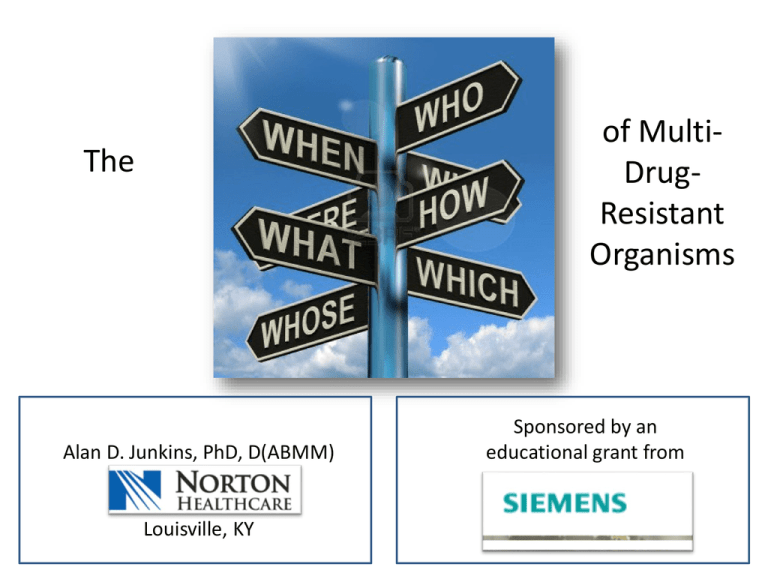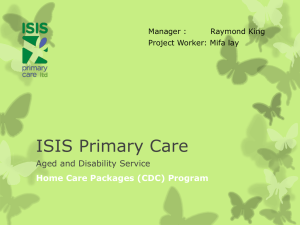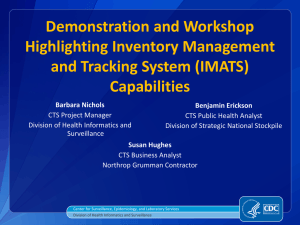2013 Spring Meeting Antibiotic Interest Group presentations
advertisement

of MultiDrugResistant Organisms The Alan D. Junkins, PhD, D(ABMM) Louisville, KY Sponsored by an educational grant from You know that Pseudomonas aeruginosa from Mr. Jones in 5F? Is that an MDRO? Why do you want to know? Why are you asking me? How should I know? Why do you want to know? Why do you want to know? • Your own internal monitoring – “We’ve had a 35% increase in MRSA isolates this year.” • For infection control purposes – “All patients with MDR GNB are placed in contact precautions.” • Reporting to authorities – “We have to report all MDROs to the state.” Why do you want to know? • Your own internal monitoring – “We’ve had a 35% increase in MRSA isolates this year.” • For infection control purposes Who defines MDRO? – “All patients with MDR GNB are placed in contact precautions.” • Reporting to authoritiesYou do, Or whomever – “We have to report all MDROs toyou’re the state. producing the data for Why do you want to know? • Your own internal monitoring – “We’ve had a 35% increase in MRSA isolates this year.” • For infection control purposes – “All patients with MDR GNB are placed in contact precautions.” • Reporting to authorities Who defines MDRO? – “We have to report all MDROs to the state. Your infection control team Why do you want to know? • Your own internal Who monitoring defines MDRO? – “We’ve had a 35% increase in MRSA isolates this year.” CDC, State, Parent • For infection controlNHSN, purposes Company – “All patients with MDR GNB are placed in contact precautions.” • Reporting to authorities – “We have to report all MDROs to the state.” Hence, the problem… Different people doing the defining… for different reasons… …leads to different definitions. I know one when I see one… …well, maybe not. The Simplest Approach The Not Quite As Simple But Now The Closest Thing We Have to Universally Accepted Approach Resistant to > 1 drug Non-susceptible to >2 classes of drugs XDR and PDR Non-susceptible to at least 1 drug in all but two or fewer classes Non-susceptible to all agents in all classes What is a “class” of drugs? Beta-lactams What is a “class” of drugs? Penicillins Cephalosporins Monobactams Carbapenems What is a “class” of drugs? Aminopenicillins 1st gen. Cephalosporins Ureidopenicillins 2nd gen. Cephalosporins Carboxypenicillins 3rd gen. Cephalosporins ß-lactamase resistant penicillins 4th gen. Cephalosporins 5th gen. Cephalosporins ß-lactamase inhibitor combinations Cefamycins Monobactams Carbapenems What is resistance to a class? Gentamicin Tobramycin Amikacin Resistant to this class? Bug A R R R Bug B R R S Bug C R S S Bug D I S S What about intrinsic resistances? • Should intrinsic resistance count toward number of classes showing resistance? • Typically chromosomally encoded; those genetic determinants are not easily passed on to other bacteria • But still can be bad boys – bad infections, bugs can be transmitted to others, hard to treat If we include intrinsic resistances in our definition, then every single Acinetobacter baumannii, Burkholderia cepacia, Pseudomonas aeruginosa, and Stenotrophomonas maltophilia we isolate would be considered MDRO. If we include intrinsic resistances in our definition, then every single Morganella, Proteus, Providencia, and Serratia marcescens we isolate would be considered MDRO. I’ll refer to this later as the “GBGX” paper. 22 drugs in 17 classes MDR – NS to at least one drug in at least 3 classes XDR – NS to at least one drug in all but 2 or fewer classes PDR – NS to all drugs in all classes 22 drugs in 17 classes 14 drugs in 13 classes MDR – NS to at least one drug in at least 3 classes XDR – NS to at least one drug in all but 2 or fewer classes PDR – NS to all drugs in all classes Standardization, but is it practical? Organism What they suggest What’s on our panel Staphylococcus aureus 22 drugs in 17 classes 14 drugs in 13 classes Enterococcus 17 drugs in 11 classes 10 drugs in 8 classes Enterobacteriaceae 32 drugs in 17 classes 23 drugs in 14 classes Pseudomonas aeruginosa 17 drugs in 8 classes 11 drugs in 6 classes Acinetobacter 22 drugs in 9 classes 14 drugs in 8 classes MDR – NS to at least one drug in at least 3 classes XDR – NS to at least one drug in all but 2 or fewer classes PDR – NS to all drugs in all classes Authors recommend additional designations: “Possible XDR” “Possible PDR” We’ll call this one the “CDC” paper. Based on 2008 SHEA/HICPAC Position Paper published in Inf Control & Hosp Epidemiol, October 2008, vol. 29, no. 10 http://www.cdc.gov/nhsn/PDFs/pscManual/12pscMDRO_CDADcurrent.pdf, January 2013 MDRO Definitions Resistant to oxacillin, methicillin, or cefoxitin, or positive by an FDA-approved test for mecA on isolated colonies or in specimens Not a MRSA http://www.cdc.gov/nhsn/PDFs/pscMan ual/12pscMDRO_CDADcurrent.pdf, January 2013 MDRO Definitions Any Enterococcus resistant to vancomycin or positive by an FDA-approved test for VRE Any Klebsiella non-susceptible to ceftriaxone, cefotaxime, ceftazidime, or cefepime*** ***Based on new breakpoints http://www.cdc.gov/nhsn/PDFs/pscMan ual/12pscMDRO_CDADcurrent.pdf, January 2013 MDRO Definitions Non-susceptible to imipenem, meropenem, or doripenem***, or positive by a test for carbapenemase ***Based on new breakpoints http://www.cdc.gov/nhsn/PDFs/pscMan ual/12pscMDRO_CDADcurrent.pdf, January 2013 MDRO Definitions http://www.cdc.gov/nhsn/PDFs/pscMan ual/12pscMDRO_CDADcurrent.pdf, January 2013 Call this one the “CRE Toolkit” Based on new breakpoints Back to CRE http://www.cdc.gov/hai/organisms/cre/cre-toolkit/ But maybe not so straightforward… http://www.cdc.gov/hai/organisms/cre/cre-toolkit/ How many CRE at Norton*? (since January 1, 2010) True Modified Hodge Positive Standard definition from CDC’s “CRE Toolkit” Take away imipenem-NS Proteus, Providencia, Morganella Include ertapenem NS isolates *We are still using the “old” cephalosporin and carbapenem breakpoints. Mandatory Reporting • Which definition to use? – Labs using old breakpoints – Labs using new breakpoints • Infections only, or include colonization? – Mandatory surveillance? – Which method? • CDC method • Chromogenic media What We’ve Done • Certain organisms are designated in microbiology laboratory reports as MDROs. • The Microbiology Laboratory makes this determination on the basis of full susceptibility results from the MicroScan and supplemental testing if necessary. • The chief intent is infection control. All patients infected with an isolate reported as an MDRO are put into contact precautions. • We continue to use pre-2009 CLSI breakpoints for cephalosporins and carbapenems with supplemental testing for beta-lactamases as necessary. • We generally do not do surveillance cultures to detect colonization, with the exception of weekly MRSA cultures in the NICU. Our MDRO Definitions • MRSA – by oxacillin or cefoxitin MIC or by growth on chromogenic medium • VRE – by vancomycin MIC; E. faecalis and E. faecium only • E. coli, Klebsiella, and Proteus mirabilis that produces ESBL enzymes • Certain Enterobacteriaceae that produce plasmid-encoded AmpC enzymes Our MDRO Definitions Our MDRO Definitions Our MDRO Definitions What about other bugs? Is this an MDRO? Amox/Clav R Linezolid S Ceftriaxone R Oxacillin R Clindamycin S Rifampin S Cefazolin R Trim/Sulfa S Daptomycin S Tetracycline S Erythromycin S Vancomycin S Gentamicin S Levofloxacin S GBGX: CDC: Is this an MDRO? Amox/Clav S Linezolid S Ceftriaxone S Oxacillin S Clindamycin R Rifampin S Cefazolin S Trim/Sulfa S Daptomycin S Tetracycline R Erythromycin R Vancomycin S Gentamicin S Levofloxacin R GBGX: CDC: Is this an MDRO? Ampicillin R Linezolid R Daptomycin S Penicillin R Nitrofurantoin I Tetracycline R Gent. Synergy S Vancomycin S Levofloxacin R GBGX: CDC: Is this an MDRO? Ampicillin S Linezolid S Daptomycin S Synercid S Nitrofurantoin S Tetracycline S Gent. Synergy S Vancomycin R Levofloxacin S GBGX: CDC: Is this an MDRO? Amikacin R Gentamicin R Amp/Sulbactam I Levofloxacin R Ceftazidime R Meropenem R Cefotaxime R Tetracycline R Ciprofloxacin R Trim/Sulfa R Cefepime R Tigecycline R Colistin S Tobramycin R GBGX: CDC: Is this an MDRO? Amikacin S Gentamicin S Amp/Sulbactam S Levofloxacin R Ceftriaxone I Meropenem R Ceftazidime S Tetracycline R Cefotaxime I Trim/Sulfa R Ciprofloxacin R Tobramycin S Cefepime S GBGX: CDC: Is this an MDRO? Amikacin R Imipenem S Aztreonam R Levofloxacin S Ceftriaxone R Meropenem S Ceftazidime R Pip/Tazo R Cefotaxime R Piperacillin R Ciprofloxacin S Trim/Sulfa R Cefepime R Tetracycline S Gentamicin R Tobramycin R GBGX: CDC: Is this an MDRO? Amikacin S Imipenem S Aztreonam R Levofloxacin R Ceftazidime S Meropenem S Ciprofloxacin R Pip/Tazo S Cefepime S Piperacillin S Gentamicin I Tobramcyin S GBGX: CDC: Is this an MDRO? Old breakpoints ESBL positive Amp/Sulbactam S Ertapenem S Amikacin S Imipenem S Ampicillin R* Levofloxacin S Ceftriaxone R* Meropenem S Ceftazidime R* Pip/Tazo S Cefazolin R* Trim/Sulfa S Ciprofloxacin S Tetracycline S Cefepime R* Tobramycin S GBGX: CDC: Is this an MDRO? Amp/Sulbactam R Ertapenem S Amikacin S Imipenem S Ampicillin R Levofloxacin S Ceftriaxone S Meropenem S Ceftazidime S Pip/Tazo S Cefazolin R Trim/Sulfa S Ciprofloxacin S Tetracycline S Cefepime S Tobramycin S GBGX: CDC: Is this a CRE? Amp/Sulbactam R Cefazolin R Ampicillin R Cefepime S Amox/Clav R Cefuroxime R Aztreonam R Ertapenem R Ceftriaxone R Imipenem I Ceftazidime R Meropenem S Cefotaxime R Piperacillin R Cefoxitin R Pip/Tazo I CDC: CRE Toolkit: Is this a CRE? New breakpoints Amp/Sulbactam R Cefazolin R Ampicillin R Cefepime S Amox/Clav R Cefuroxime R Aztreonam R Ertapenem R Ceftriaxone R Imipenem I Ceftazidime R Meropenem S Cefotaxime R Piperacillin R Cefoxitin R Pip/Tazo I CDC: CRE Toolkit: Is this a CRE? New breakpoints Amp/Sulbactam R Cefazolin R Ampicillin R Cefepime S Amox/Clav R Cefuroxime R Aztreonam S Ertapenem S Ceftriaxone S Imipenem I Ceftazidime S Meropenem S Cefotaxime S Piperacillin R Cefoxitin R Pip/Tazo S CDC: CRE Toolkit: Is this a CRE? Amp/Sulbactam R Cefazolin R Ampicillin R Cefepime S Amox/Clav R Cefuroxime R Aztreonam R Ertapenem I Ceftriaxone R Imipenem S Ceftazidime R Meropenem S Cefotaxime R Piperacillin R Cefoxitin R Pip/Tazo I CDC: CRE Toolkit: So what to do? • Will the lab designate isolates as MDRO? • Why? What’s your purpose? How will the data be shared? • Create meaningful definitions that fit your purpose. • Continue to follow good selective reporting, but include non-reported drugs in determining MDRO status. • Make determination of MDRO status as easy as possible. Automate if possible. And thanks to Siemens for their sponsorship of this program.








